Node Editor
![]()
Page content
- General
- The Node Editor
- Navigating the NodeEditor
- Node Editor header
- The Navigator
- The Info Area
- The input and output sections
- Other Node Editor Elements
- Special features of the Scene Node Editor
- Node Editors modes
- Working with Nodes
The Node Editor has different modes, depending on which Node type is used. For example, if you enable the Scene Manager, the Scene mode (see also Scene Nodes Introduction) will be used; if you enable a Node Material, the Material mode will be used. In the following you will find references to the fact that a particular function will only work in a particular mode.
General
 Example Node Editor setup in Material mode.
Example Node Editor setup in Material mode.
For quicker access to all assets, Capsules and Nodes can also be displayed on the left side of the Node Editor in addition to the Asset Browser. Furthermore the Attribute Manager can also be displayed on the right edge of the Node Editor in order to edit a Node's settings directly in the Node Editor. This is especially helpful when working with a fullscreen or floating Node Editor window and when configuring Node Materials for a faster workflow. The icon for hiding and displaying the Asset Browser and the Attribute Manager is located at the top-right of the Node Editor.
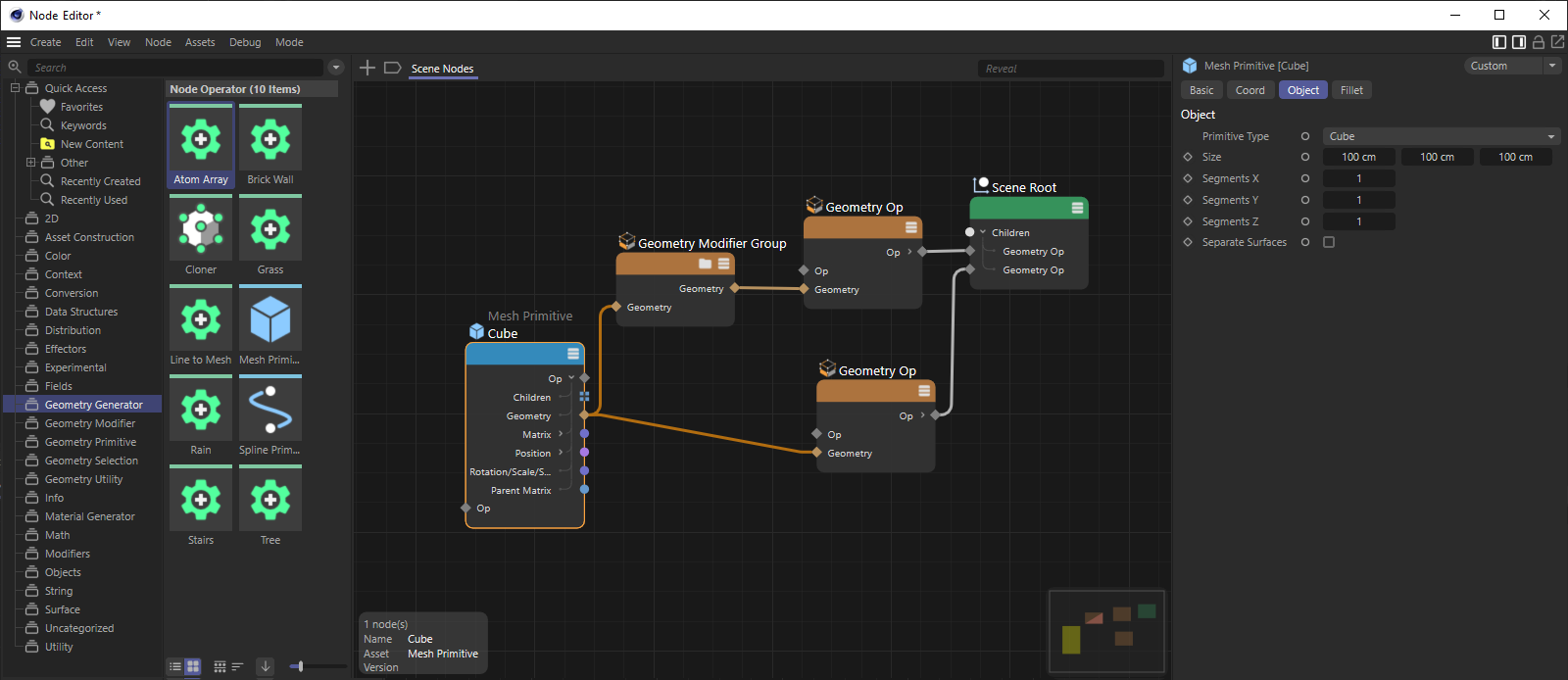 At the edge of the Node Editor you can hide or display the Asset Browser or Attribute Manager, respectively.
At the edge of the Node Editor you can hide or display the Asset Browser or Attribute Manager, respectively.
The following applies to the Node Editor (Material mode):
The Node Editor is where everything takes place when creating and editing Material Nodes (in the following referred to as Nodes). To create and edit Nodes, a Node Material must be selected. The Node Editor always displays the currently selected Node Material.
Please note that Nodes are quite complex and to use them effectively you need to have a higher level of knowledge about how shading and rendering works in general. However, several functions are very simple when a pre-defined material is used such as the Redshift Default Material, which is almost as easy to use as a normal material.
The general flow of data is always from left to right. At the far right at the Redshift materials, everything must always culminate in an Output-Node (no Material Node means no working material; only 1 Output Node per material).
The Node Editor can be opened as follows:
- Double-clicking on the Node Material in the Material Manager
- Clicking on a Node Material's Node Editor button (Basic tab in the Attribute Manager)
A description of all Redshift Material Nodes can be found here. The description of the Nodes in the older Cinema 4D material system can also be found here.
The following applies to the Scene Node Editor:
The Node Editor's content is not assigned to a specific element (such as the Material Node Editor to a Node Material) but is itself displayed in the scene. Therefore, the last output Node must always be connected to the scene Node, which is present by default,via its Op Output , otherwise no geometry will be generated.
Note that the Scene Node Editor is currently only designed for advanced users and a higher 3D skillset and technical knowledge is needed. See Scene Nodes Introduction for a brief introduction.
The Scene Node Editor is opened via the Scene Node Editor command in the main menu (Window / Scene Node Editor).
The Editor also offers several special functions that are described farther down.
As with the Node Materials when they were introduced, the Scene Editor comes with a range of additional Nodes for specific uses. Many Nodes (such as the Math Node) are available in both the Material Node Editor and in the Scene Node Editor. A description of all Scene Nodes can be found under Individual Assets.
Several special Viewport settings for displaying geometry generated by the Scene Node Editor are available in the Project Preferences menu (see Nodes).
The following applies to the Node Editor (Capsule mode):
This mode is somewhat different from the previous two modes because it is activated automatically if a Node is removed from the Asset Construction Node group, e.g., dragged into the Object Manager or selected there. These Nodes make up the basis for the creation of Asset Capsules, with which you can, for example, create custom objects, selection methods, deformers or modeling commands and, among other things, combine them directly with normal objects in the Object Manager. Since these Nodes work like a group, the Node Editor will automatically display the content of the selected Asset Construction Node. However, if a conversion to an Asset was already done, the Capsule mode will be activated but the content of the Asset can no longer be displayed directly in the Node Editor. The Asset would, for example, have to be converted back to a group.
The content of the Node Editor is not associated with a specific element (e.g., as the Material Node Editor is associated with a Node Material) but is embedded in the scene itself. Therefore, the Op Output of the last output Node must always be connected with the Scene Node, otherwise no geometry will be generated.
Node Editor
Navigation:
As with other Managers; the following hotkeys can be used to navigate in the Node Editor (see also commands in the View menu):
-
Move: Press one of the following keys and drag the mouse: MMB, 1 + LMB, Alt + MMB or click and drag in the Navigator. If Touchscreen is enabled in the Preferences menu (Input Devices menu), the following will also be enabled:
Mouse wheel up/down (move vertically) and Shift + mouse wheel (move horizontally) - Zoom: Press one of the following buttons and drag the mouse: Alt + RMB, 2 + LMB, mouse wheel (if Touchscreen is enabled: Ctrl + mouse wheel)
- Show all or selected: H or S.
If you have the Navigator section open at the bottom right of the Node Editor (this can be opened via "Show Navigator" in the "View" menu), it can be used for navigation. Simply click on the location in the Navigator that you want to display centered in the Node Editor.
The Node Editor offers a similar simplification of the Node display when zooming out of a setup. The Nodes' details and their text will be reduced continuously and finally hidden completely if you zoom out far enough. This way you can still see which Nodes are used and how they're connected even when you're zoomed out. The following series of images demonstrates this.
 This series of images shows from top to bottom how details are automatically reduced the farther you zoom out.
This series of images shows from top to bottom how details are automatically reduced the farther you zoom out.
Creating Nodes
Nodes can, for example, be created in the following ways.
-
In the Asset Browser:
- Drag a Node from the Asset Browser into the Node Editor.
- Click on the Add Node button (Plus icon at the top-left of the Node Editor) or
- Double-click on an empty space in the Node Editor (or press the C key), which will open the respective Asset List in the Asset Browser. - If a bitmap file is dragged from the Finder/Explorer or the Asset Browser directly into the Material Node Editor, a Texture Node (for Redshift a Redshift Material) or an Image Node (for a Cinema 4D Node Material) will automatically be created.
- Existing Nodes in the Node Editor can be duplicated via Ctrl + drag & drop, as you know it from the Object Manager.
The Preset System lets you save settings, e.g., for tags, objects, color gradients, brush tips or Nodes for quick access. Presets can be defined as defaults, which will make them available when the respective element is called up. Otherwise these settings will be managed in the Asset Browser where they can be accessed anytime. Additional information about the Preset System can be found here.
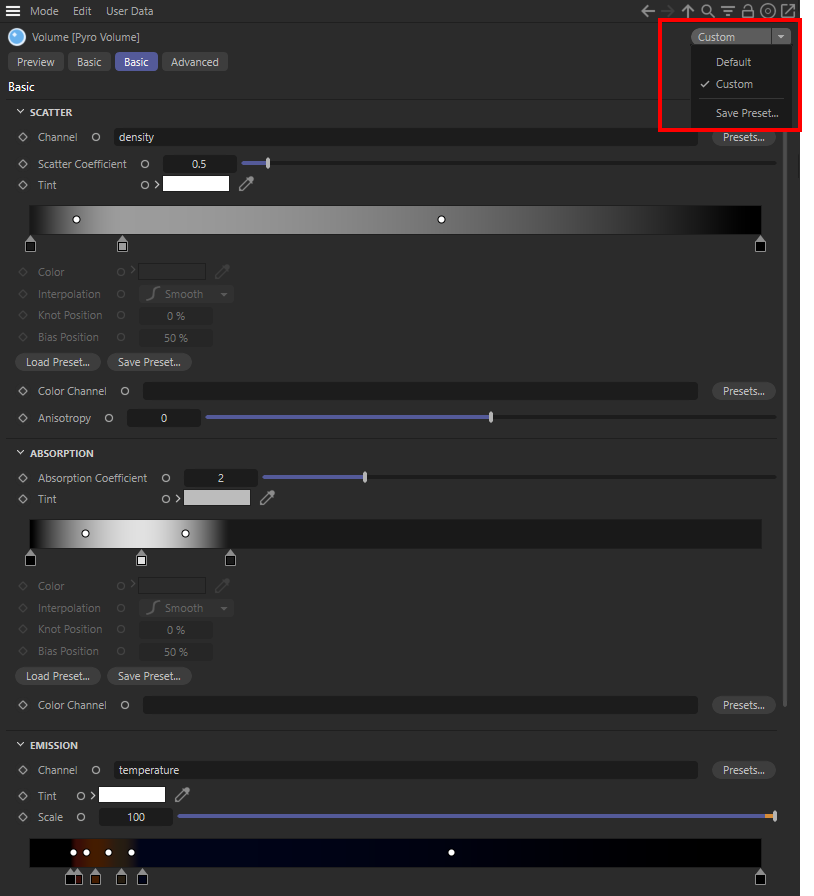 As with objects, for example, the settings for Nodes can also be managed. This makes it possible - especially when using Material Nodes - to quickly access specific settings, e.g., for different materials.
As with objects, for example, the settings for Nodes can also be managed. This makes it possible - especially when using Material Nodes - to quickly access specific settings, e.g., for different materials.
Especially when configuring Redshift materials you will see that identical Nodes with individual settings are used. Think of a Pyro Volume Node, for example, that is used for simulating flames, explosions or smoke. Once you've found settings that you are satisfied with simply use the Preset Menu in the top-right corner of the Attribute Manager to save a new Preset. Note that this menu is not available in the Attribute Manger of the Node Editor but only in the Attribute Manager in the Cinema 4D layout.
The following options are available::
- Presets: In the top part of the menu you will find the Presets that have already been saved and can be called up directly. If no default settings were saved for the currently selected element, this part of the menu will be empty.
- Default: Each Node, each object and each tag has a non-modifiable default setting that will be applied automatically, e.g., if a Node is called up, if no custom default setting was activated. If you have made changes to the settings that you want to undo, select this menu item to reset to the default settings.
- Custom: As soon as you modify settings, i.e., if you, for example, configure a Node differently from the default settings, a Custom Preset will be displayed. These settings can be saved using the next options.
- Save Preset: This option lets you open a Save dialog window in which you can, among other things, assign a name to the settings. After it's been saved you will find this name in the Preset Menu for quick access. Furthermore, these settings will be stored in the default database of the Asset Browser.
By checking the As Preset option, the saved Preset will be used as the default and automatically applied when the respective Node, tag or object is called up.
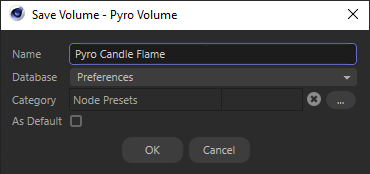 Dialog window for saving Presets.
Dialog window for saving Presets.
All Presets will be saved in the Attribute Manager and can be viewed in the Presets tab. Here you can delete any superfluous Presets or rename them. In the Context Menu you will find respective functions that can be opened for a Preset by right-clicking on them. Furthermore, Presets can also be defined as a default at a later stage in case yo forgot to do so initially. To do so, place the cursor over the respective Preset's icon on the right side of the Asset Browser. Two additional symbols will appear on the preview:
- Heart: By activating the Heart symbol, you can create as many favorites as you want. This property can, for example, be used to filter search results in the Asset Browser or to simply locate an item faster.
- Crown: This marks the Preset as a default that will be automatically applied when a respective Node, tag or object is called up. Only a single Preset can be marked with a Crown for a respective element.
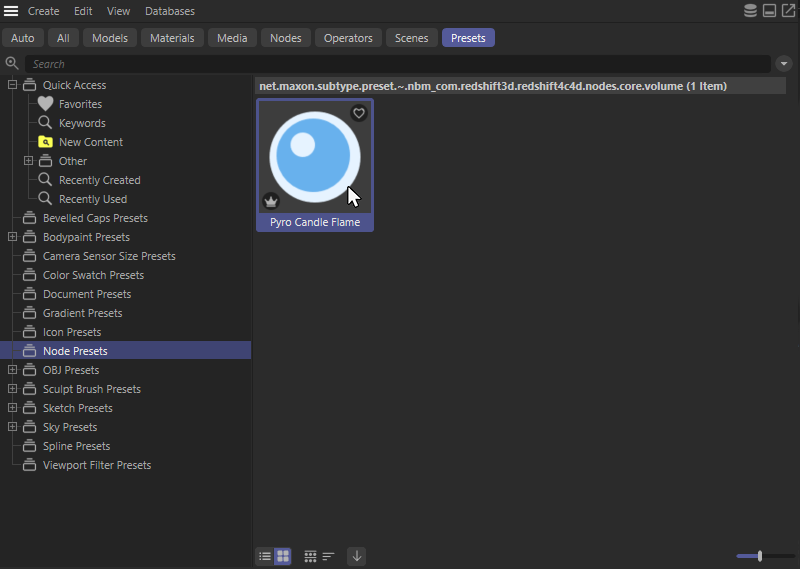 A list of saved Presets in the Asset Browser. Additional options for marking as a favorite or default will appear when the cursor is placed above the respective Preset.
A list of saved Presets in the Asset Browser. Additional options for marking as a favorite or default will appear when the cursor is placed above the respective Preset.
Moving Nodes
Nodes can be moved at any time by clicking and dragging them. Multiple selections will be moved as a whole. If you move your selection to the edge of the Node Editor view, the view will start to scroll correspondingly. Multiple selected Nodes will be moved together. If they approach the edge of the Node View, the Node View will scroll accordingly. To select the Nodes you can click and drag a box around them with the LMB or simply click on a single Node. Shift+click to make multiple selections. Ctrl+click on a selected Node to deselect it.
Connecting Nodes and creating Ports
:
In order to let data flow from one Node to another they must be connected: For this, Node outputs (right Node side) of one Node can be connected with the inputs of another Node (left Node side). To do so:
- click once on the output port and once on the input port (or vice-versa). This is very practical for Nodes that lie far apart from one another.
- click and drag from the first port to the second and release the mouse button.
- In both cases you can "drop" the connection end onto the middle of the Node: a list with all input and output ports will be displayed from which you can make a selection (if you drop the connection onto an empty area, input/output ports for groups can be drawn out).

- If a connection to a Port already exists that should also lead to other Ports, this connection can be duplicated by pressing Ctrl+Shift and leading it to another Port. This can be particularly useful if the Output Port of the existing connection lies outside of the area that lies within view in the Viewport. The following image shows and example of this.
 An existing connection is duplicated via Ctrl+shift+drag and drop and can also be lead to other ports.
An existing connection is duplicated via Ctrl+shift+drag and drop and can also be lead to other ports.
- In the Attribute Manager you will find a circular Connector icon for just about all Inputs..
 Node settings that can be used as Input Ports have a special Connector icon (marked) in the Attribute Manager.
Node settings that can be used as Input Ports have a special Connector icon (marked) in the Attribute Manager.
- The previously mentioned Connector icon for a Node setting in the Attribute Manager can also be used to create a Port for this value for that Node. To do so, simply Ctrl + click on the circular Connector icon.
 The left image shows the cursor pointing to a Connector icon next to a Node setting in the Attribute Manager. By Ctrl+clicking on the icon you can add the corresponding Input POrt automatically to the Node (if it is not visible).
The left image shows the cursor pointing to a Connector icon next to a Node setting in the Attribute Manager. By Ctrl+clicking on the icon you can add the corresponding Input POrt automatically to the Node (if it is not visible).
The following applies:
- As long as you're in connecting mode (clicked on the first port to be connected), the mode can be disabled by pressing Esc on your keyboard
- Existing connections can be "re-routed" at the port or the connection itself by Shift+clicking on other ports (even other Nodes).
- Erroneously created connections can be removed by double-clicking on the connection line.
- Only ports whose data types are compatible can be connected. .
Cinema 4D will attempt to convert differing data types if possible but this is not always possible. Cinema 4D will inform you if a connection is possible: as long as you hover over the port with which you want to connect, a Stop symbol will appear if no conversion can be made.
Optimizing connections
When connecting ports, connector lines can intersect or run across other Nodes. This can negatively affect the readability of the setup. Connections can also be run through a detour point. The advantage of this can be seen in the images below.
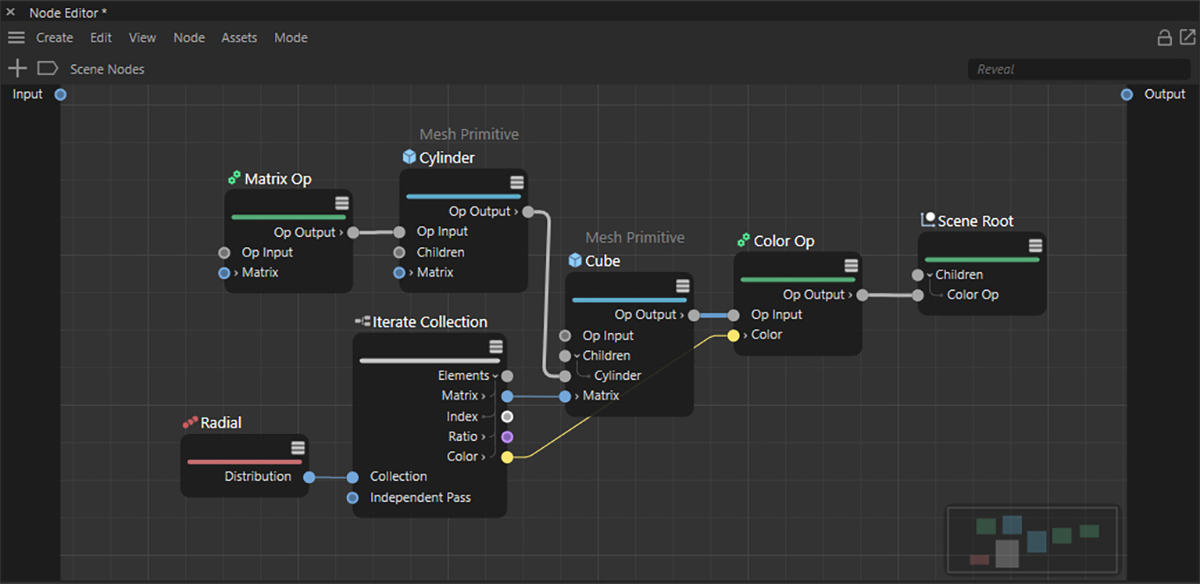 In this example, the connection for the color value of one Node was partially covered.
In this example, the connection for the color value of one Node was partially covered.
In order to improve the readability of the setup, connector lines can be subdivided additionally. Similar to adding a new point to a linear spline, the course of a connector line can be modified individually. To do so, simple Shift+ Ctrl + left-click on the connector line that you want to modify. This way you can add any number of detour points along a connector line. To remove a detour point, click on it and press Del on your keyboard.
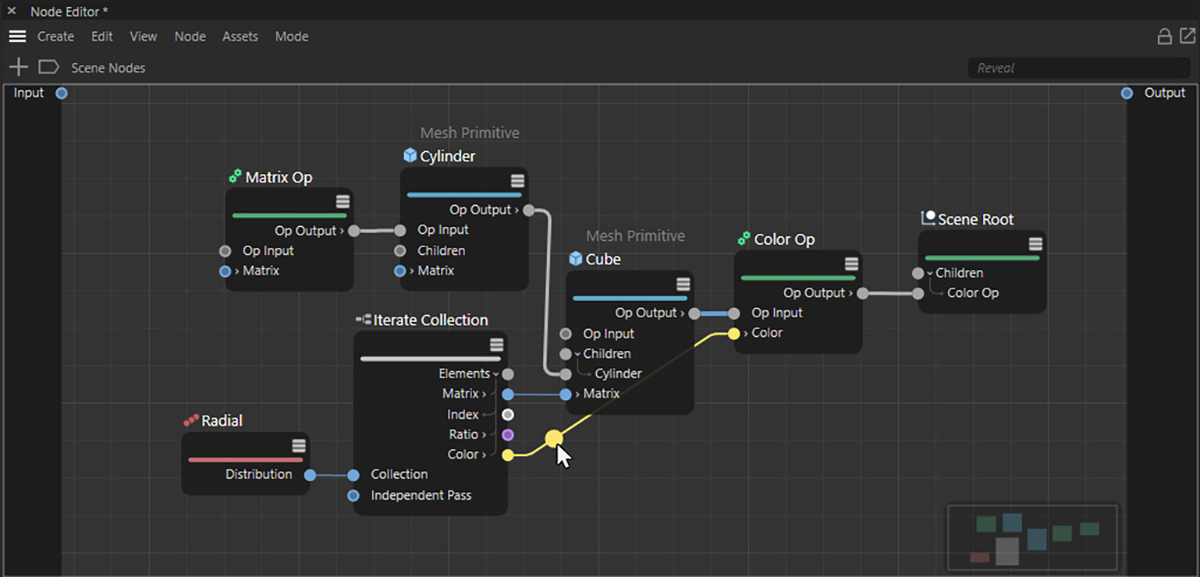 Shift + Ctrl + hover over a connector line to create a detour point, which can be moved freely. Alternatively you can simply press Shift and Ctrl + left-click on a connector line to create a detour point.
Shift + Ctrl + hover over a connector line to create a detour point, which can be moved freely. Alternatively you can simply press Shift and Ctrl + left-click on a connector line to create a detour point.
A detour point can be grabbed and moved with the mouse. The course of the connector line can be modified freely. Detour points can be added to create more complex detours.
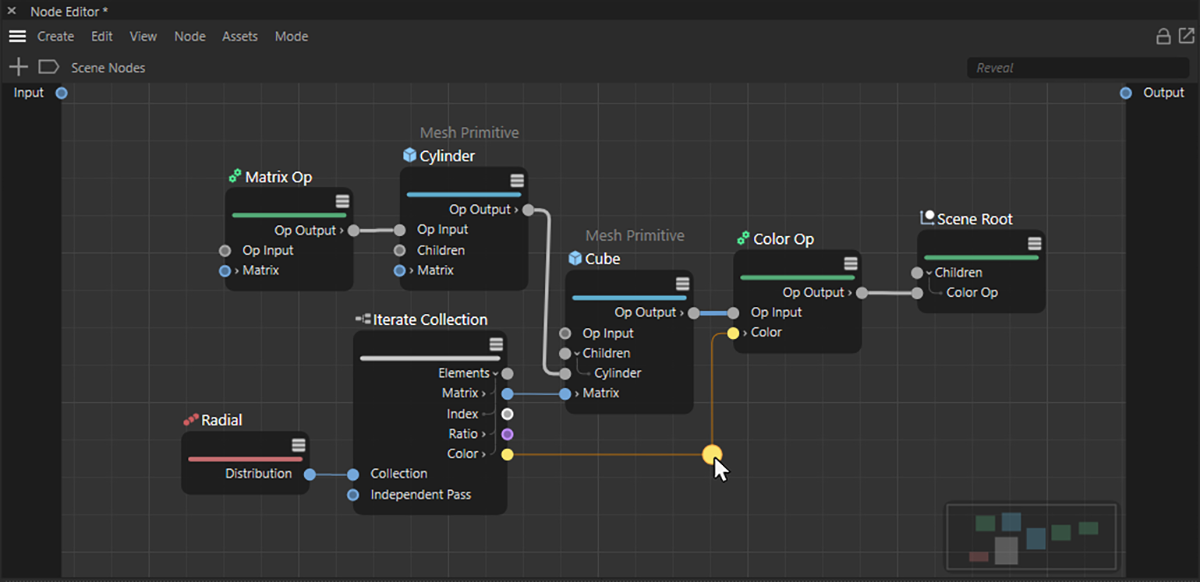 The detour point can be moved with the mouse to modify the course of the connector line. In this example, the lines overlapping the Node can be moved.
The detour point can be moved with the mouse to modify the course of the connector line. In this example, the lines overlapping the Node can be moved.
This option can be used to make horizontally running setups in particular easier to read.
 The more complex a setup becomes, the more overlapping that can occur. In this example, you can't properly see the connections between the mathematical Nodes at the center of the setup.
The more complex a setup becomes, the more overlapping that can occur. In this example, you can't properly see the connections between the mathematical Nodes at the center of the setup.
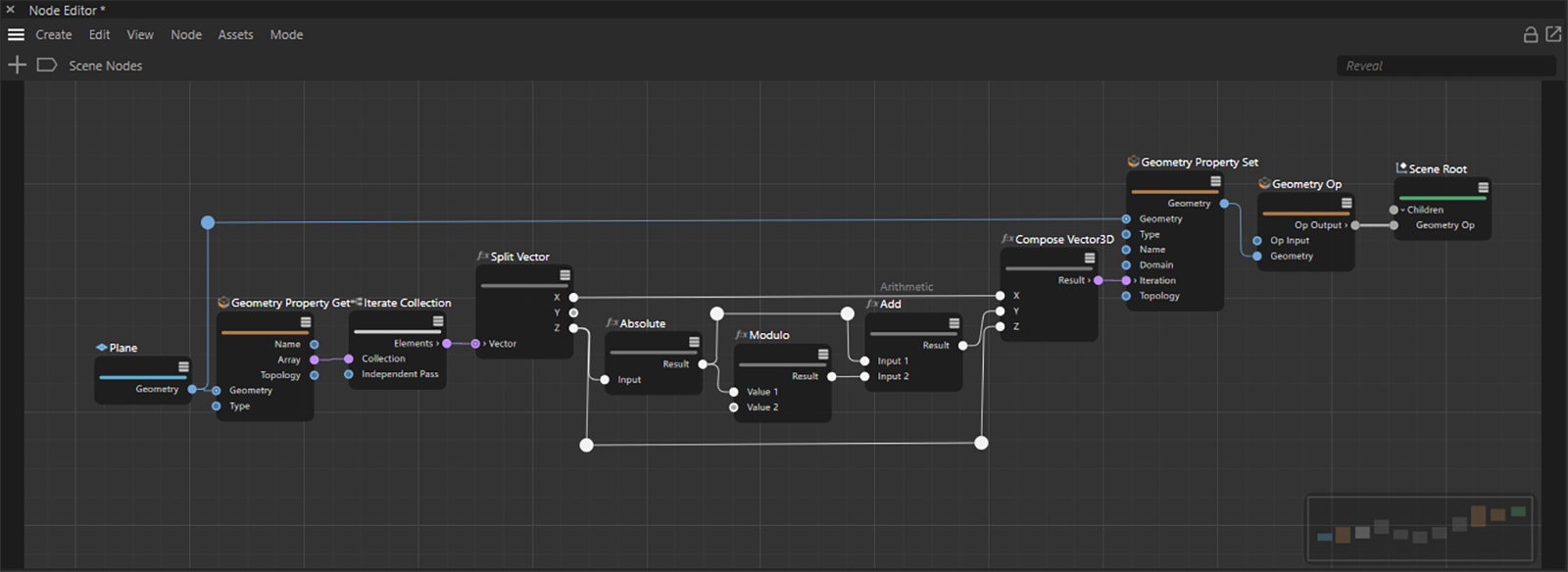 Using detour points, the setup can be made easier to read.
Using detour points, the setup can be made easier to read.
Detour points can not only be used to modify connector lines but can also make data available that should be passed via the connector lines. The can therefore also be used as branch points for a given connections, as shown in the example below.
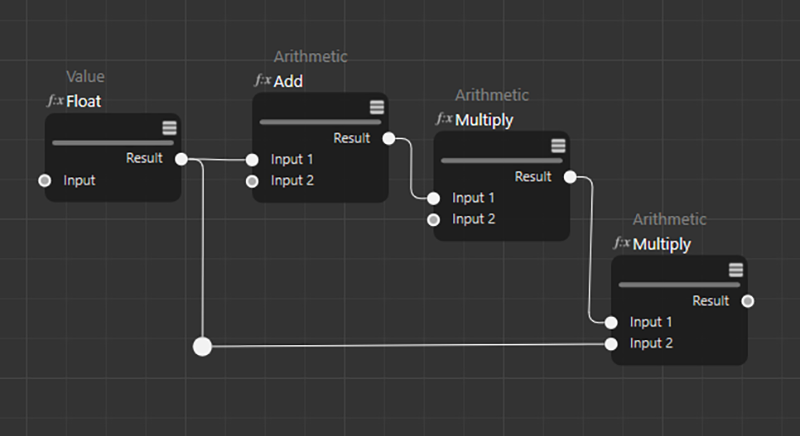 Here a detour point was used to improve the readability of the setup.
Here a detour point was used to improve the readability of the setup.
If the cursor is moved in the vicinity of a detour point, two port points will be displayed, from which a new connection can be dragged when clicked upon.
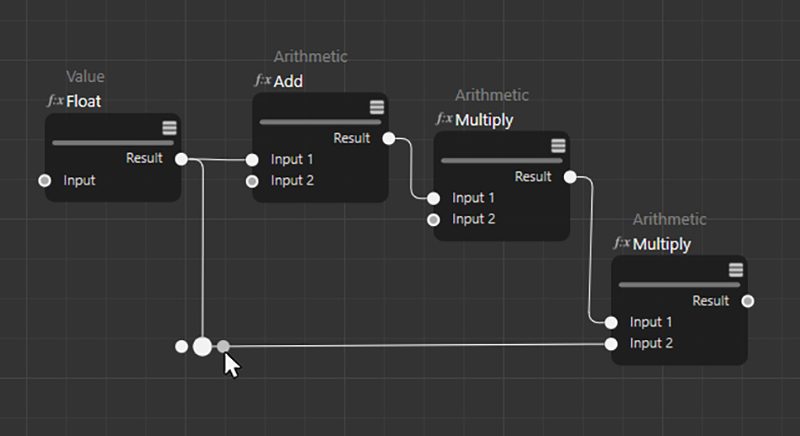 Additional points will be displayed when the cursor is placed near a detour point.
Additional points will be displayed when the cursor is placed near a detour point.
A detour point can be used like an Output port by linking the ports with a detour point with other Node inputs.
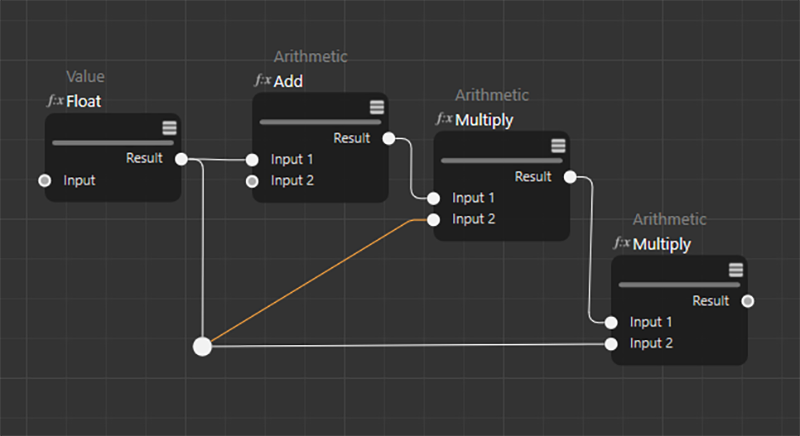 A detour point can be used like a port and also use additional connector lines.
A detour point can be used like a port and also use additional connector lines.
Existing detour points can be duplicated by Ctrl + drag & drop and placed outside of an existing connector line in the Node Editor. If a connector line is then dragged from such an independent detour point, the free-standing detour point can be used as a Value Node. You can then click on the detour point and enter a value via the Attribute Manager, which will be passed to the connected Node.
This function can also be very useful for making the setup more readable because detour points also have Basic settings in the Attribute Manager that can, for example, be used to add a comment to an applied value or modify a detour point's disaply color.
 An existing detour point can be duplicated via Ctrl + drag & drop and placed anywhere in the Node Editor. If such a free-standing detour point is then connected with a Node input, the detour point can be used to input a value.
An existing detour point can be duplicated via Ctrl + drag & drop and placed anywhere in the Node Editor. If such a free-standing detour point is then connected with a Node input, the detour point can be used to input a value.
Selecting Nodes
Nodes can be selected dragging a rectangle around them (simply press and hold the LMB and right-click on an empty area of the Node Editor view and drag) or by clicking on them. As always, the Shift and Ctrl/Cmd keys cam be used in conjunction with making selections. In the Edit menu you will find several additional selection commands (such as Select Connected). The selected Nodes’ settings are displayed in the Attribute Manager. This also applies to detour points.
Deleting Nodes
Selected Nodes can be deleted by pressing the Backspace- and Del- keys. This also works with detour points.
Node Editor Title

At the very top of the Node Editor you will find the following elements (from left to right):
- Add Nodes: Clicking on the plus symbol will open the Asset Browser's asset list. Double-clicking in the Node Editor will also open an Asset Browser. Alternatively, the left-most icon in the top-right corner of the Node Editor can be used to permanently display the Asset Browser on the left edge of the Node Editor. Here you can find out more about how these icons work.
- Node Search Path:Clicking on the Bookmark icon will open an separate window in which you can enter a Node's path. This is particularly useful when using the Heat Map function in order to navigate directly to a specific Node or Group within a complex setup. You can learn more about using the Heat Map function to analyze a Node setup here.
- Node Path: The hierarchy tree will be displayed next to the bookmark icon that is currently displayed in the Node Editor. The term "Scene Nodes" stands for the top-most layer. If you're working on Material Nodes you will instead see the name of the respective material. When in Capsule mode, the name of the Asset Construction Node that is shown will be displayed. If you combine Nodes into groups and then open these groups you will have navigated one hierarchical layer deeper. Correspondingly, the Node path will be expanded by the name of the opened Node group. Clicking on the respective part of the Node Path you can navigate to a higher level in the hierarchy. This is the same principle as the navigation through the hierarchy in the Object Manager. The Node path displayed always shows the deepest hierarchical levels that you have viewed by opening Groups. This makes it possible, for example, to quickly switch back-and-forth, e.g., between the top-most Node level and the Nodes in a deeper sub-group by simply clicking on the respective section in the displayed path. The hierarchy currently displayed in the Node Editor is highlighted by a blue underline.
- Highlight: Enter a series of characters here that affects the Nodes displayed. Nodes whose names contain this series of characters will be displayed more prominently by fading all other Nodes. This can help when looking for specific Nodes among a myriad of Nodes.
- The icons at the top-right of the Editor can be used to display or hide the Asset Browser and/or Attribute Manager on the sides of the Node Editor. Furthermore, the Lock icon can be activated to lock the current Viewport view. The fourth icon will call up an additional instance of the Node Editor. You can read more about these four icons here.
Navigator
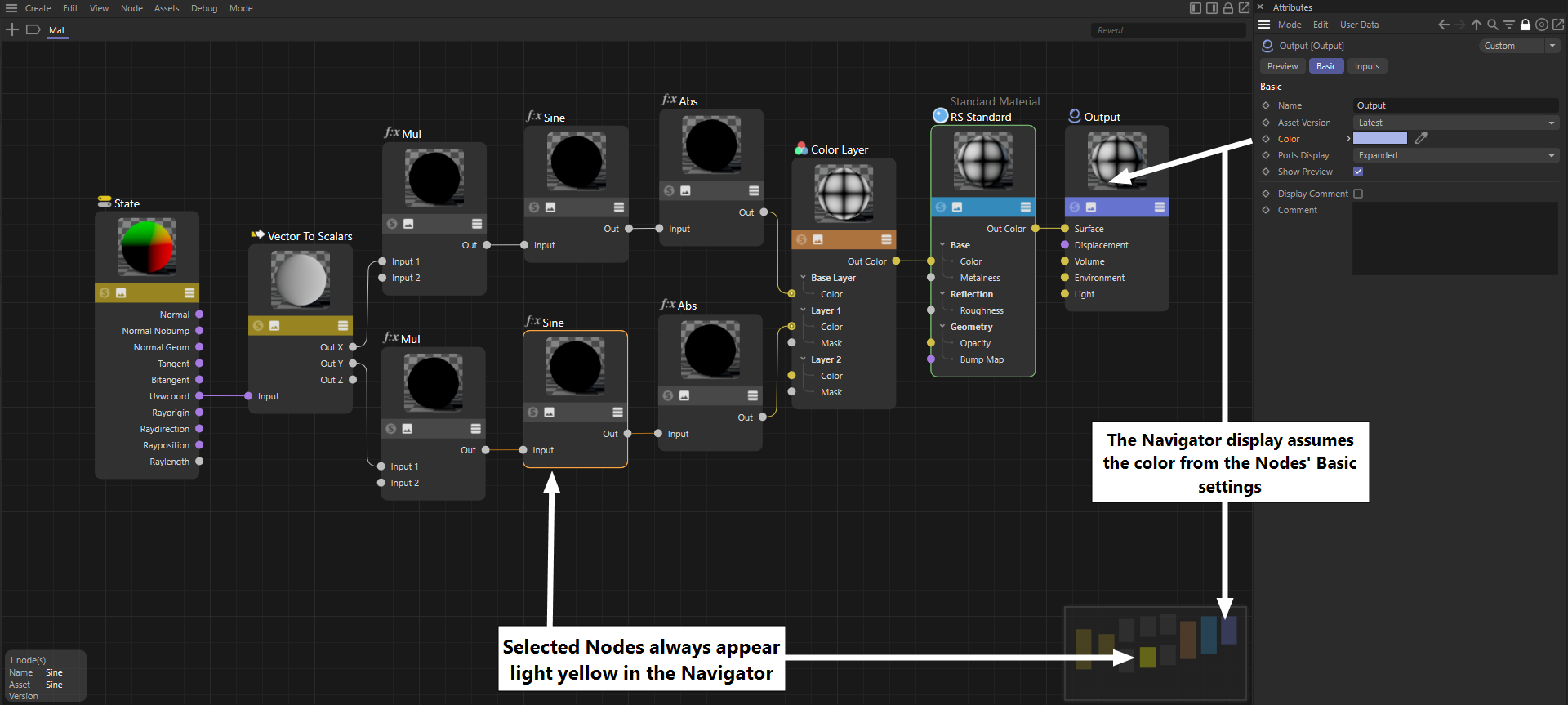
The Navigator is located at the bottom right of the Node Editor view - it's a small depiction of the entire Node constellation and serves for better orientation and quicker navigation, especially for complex Node setups. The light gray triangle shows the visible part of the Node Editor view. You can move this section by clicking and dragging in the view. By simply clicking on the Navigator you can display the respective section centered in the Node Editor.
The following Nodes have a special display:
- Colored Nodes (Basic tab) will be displayed with the identical color
- Selected Nodes will be displayed in bright yellow
- Group Nodes will be displayed with a diagonal element
 Group Nodes will always be displayed in two colors, separated diagonally. The Nodes color will be on the left and a red tone will be displayed on the right, as at the left of the image above. If y Group is selected, the display will be in yellow tones, as on the right side of the image above.
Group Nodes will always be displayed in two colors, separated diagonally. The Nodes color will be on the left and a red tone will be displayed on the right, as at the left of the image above. If y Group is selected, the display will be in yellow tones, as on the right side of the image above.
Input and Output Group Areas
On each side of the Node you will see a dark edge (if output ports were already created). Connections/ports can be output with these areas by dropping a new connection into an empty region of the area. This makes little sense for individual Nodes but if you combine different groups with one another, you can use this method to create a port that is shown as a group port (as in the image below). This means that even in a group within a group a specific Node port at the very bottom can be connected from the outside (or as an output to the outside).
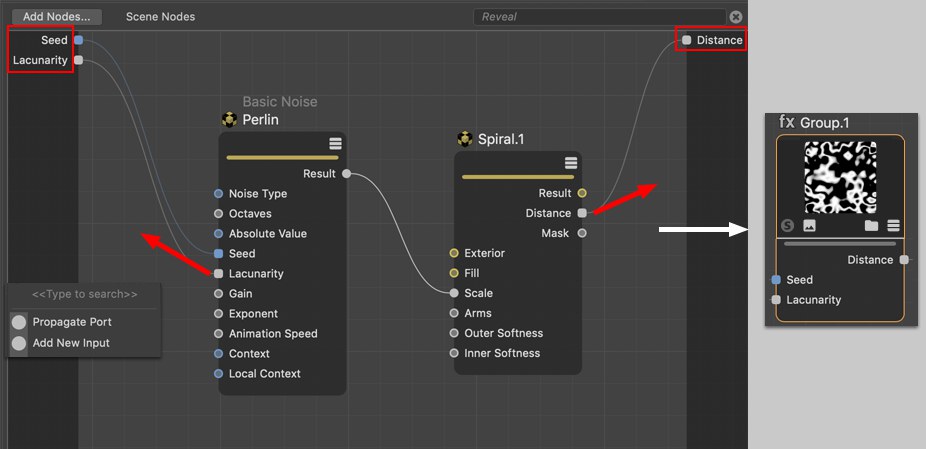 Node ports in groups can be led outside.
Node ports in groups can be led outside.
When a connection is released in an empty area, a small menu will open (see image bottom left) with the following options:
- Add New Input, round port: Here, the connection can be deleted without deleting the input. An input can be re-connected from the inside.
- Propagate Port, square port: If you remove the connection here, the port will also be deleted. Ports also pass on their properties to the outside, which, however, is currently barely used.
- Node List: Here you can select the Node whose input you want to connect with the current Input port.
Parts of the described functionality (creating inputs) can also be done via the port context menu commands.
General information about Nodes
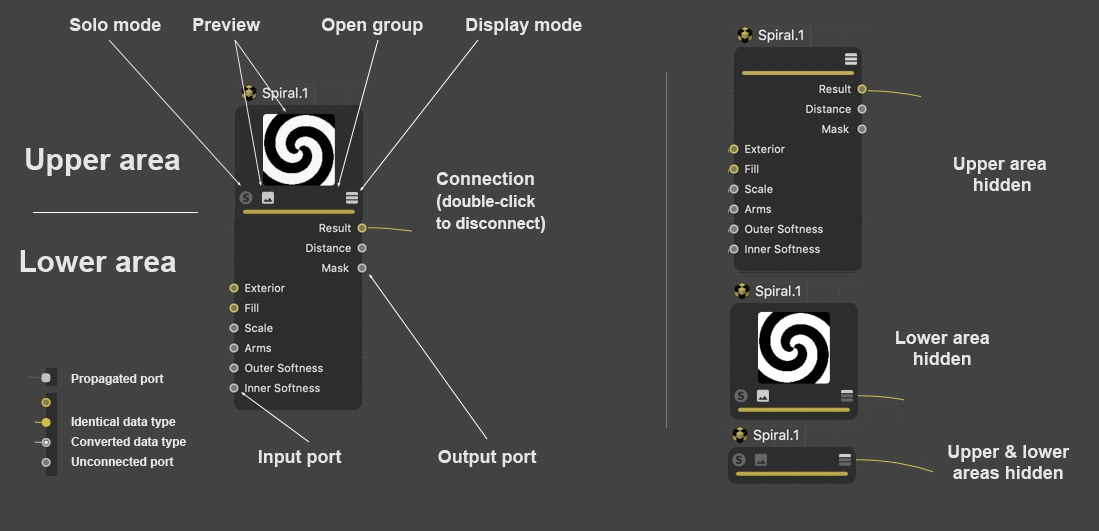 A Node setup and display example (it's also possible to only display connected ports).
A Node setup and display example (it's also possible to only display connected ports).
The core component of the Node System is - logically - the Node. A Node has inputs into which data from other Nodes is entered, which is then processed by the Node and the result is passed to its outputs. Inputs and outputs have ports through which the connection to other Nodes can be made. Basically, an input port can only have a single connection and output can have any number of connections.
Nodes can be grabbed on the left or right edge and made wider or narrower.
A Node has an upper area and a lower area:
Upper area
The Node's name is displayed over the respective Node. If you rename the Node in the Basic tab, its new name as well as the original name will be displayed. The latter so you always know which type of Node you're working with. This is also the name used in the Help. The name in white text can also be modified by double-clicking on it.
The upper Node area contains the Node preview - for Nodes wherever it makes sense. If the settings of the connected input Nodes change, the preview will change accordingly. You can show or hide the preview using the small icon (2nd from the left) (a command can also be used - see above). Since the calculation of this preview requires a lot of time, you can leave it hidden. This option can be found in the Option Preview of the new Node in the Node Editor settings.
In the Preview you will find the Solo Mode option on the left (see Solo) if the Node Preview is supported, which is, for example, not the case for Nodes for the Scene Node. Next to it on the right is the Preview icon.
You can click on the third icon (only visible for Group Nodes) to display the group content in the Node View (double-clicking on the Node will do the same).
The Display Mode icon at the far right can be used to switch between port display modes, as can be done using the three port commands .
Below the row of icons you will see a color bar whose color is defined using the Color setting in the Basic tab. This can make it easier to find certain Nodes. By default, some Bode types are already colored but can be recolored at any time.
Lower area
The lower area contains the input ports and the respective output ports on the right with their respective names. Ports can be hidden, and their order can be changed by moving them. Note that not all input ports will necessarily be listed in the Node itself. These can be displayed using the context menu.
Certain Nodes (such as the Layer Node, for example) even have drop-down port groups for each layer.
Depending on the data type being processed, ports will be assigned a certain color and in part different shapes (see next data types).
Ports can be selected (using the Shift or Ctrl/Cmd keys to add or remove selections) so they can be affected by certain commands (see Node menu or context menu).
There are also so-called variadic Inputs and Outputs on several Nodes. This means that any number of these ports can exist. A common example for this would be the Child object Inputs on a Scene Node. Via the Add Children and Remove Children functions, which can be found in the Node's Basic settings in the Attribute Manager, the required number of ports can be defined individually. This can be done even faster if you place the curson on the right next to the name of this Input on the Node. A Plus icon will appear that can be clicked on to add a new Input of this type directly in the Node Editor. If you place the cursor next to the ports below, a red X symbol will appear. Clicking on this will remove the port from the Node.
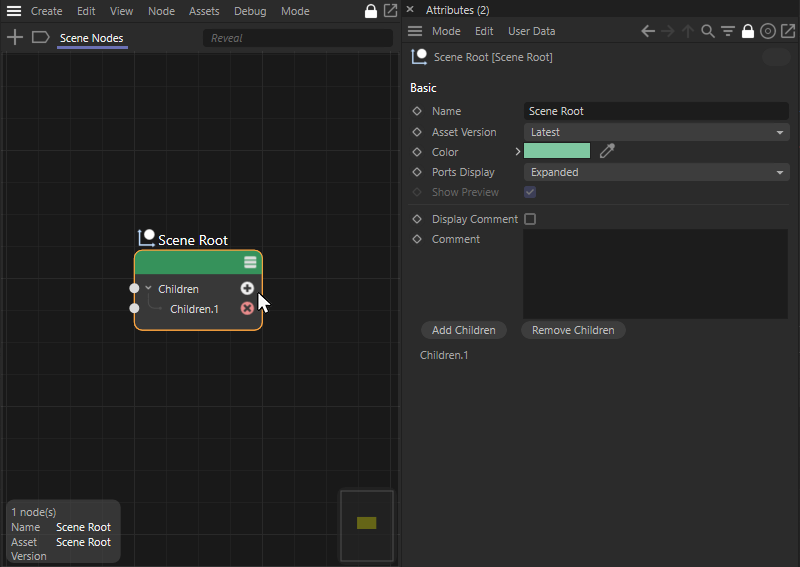 The number of variadic ports can be defined directly on the Node by clicking on the Plus and X symbols, respectively. Otherwise you can add or remove Children in the Node's Basic settings.
The number of variadic ports can be defined directly on the Node by clicking on the Plus and X symbols, respectively. Otherwise you can add or remove Children in the Node's Basic settings.
Data types and colors
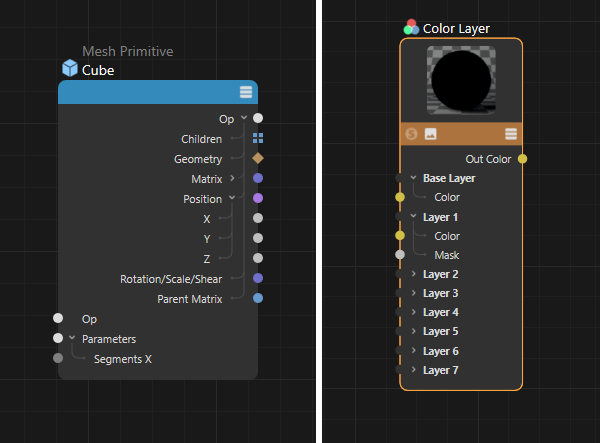 On the left is a cube primitive's Scene Node, on the right a Color Layer Node from the Redshift material system.
On the left is a cube primitive's Scene Node, on the right a Color Layer Node from the Redshift material system.
Inputs and outputs are colored accordingly. Fitting data types for input and outputs will be displayed using colors. The most important types are:
- LIght gray circles Represent complex data types that can transfer data packs with different data types. In the image above, for example, this affects the Cube object's Parameter Input as well as its Op Input and Output.
- Blue rectangular surfaces Mark data sets that are in a Collection or in Arrays. This port type can, for example, be seen in the image above at the Cube object's Output side. Object distributions will also be passed on via such ports and can then contain color values in addition to matrices.
- A brown hash tag is for geometry, i.e., for splines as well as the points, edges and polygons of Scene Nodes.
- Violet ports manage matrices but can also simultaneously process multiple vectors, e.g., for position, scale, orientation or saving.
- Pink ports are designed for use with vectors, e.g., a position vector or Normal maps.
- Gray ports process float comma values. This can, for example, be grayscale maps or simple numeric values that contain post-decimal positions (see Segment X or Position X on the Cube Scene Node).
- Light blue ports are used for various data types, e.g., for selections or settings modified via menus. You can find out which data type a port uses by clicking on the port name and viewing the Info area in the Node Editor.
- Dark gray ports are designed for use with integer numeric values, i.e., for numbers that have no post-decimal positions. You can recognize this port type in the image above, e.g., next to the Segments X Input on the Cube Scene Node.
- Yellow ports are reserved for color values. In addition to the regular color components red, green and blue, a color's alpha information can also be exchanged.
- Green ports process Boole signals, e.g., the state of a give option (on or off). This information can also be converted automatically to the numeric values 0 for off (FALSE) and 1 for on (TRUE).
- Dark ports are often only used for grouping, e.g., as in the image above on the Layer Color Node from Redshift(Base Layer, Layer 1, Layer 2, etc.).
As in XPresso, atypical input and outputs can be connected with one another. As a rule, a constructive conversion of the data types will take place. For example, a texture can also be connected to an input for a float comma value. The texture's RGB values will then automatically be converted to brightness values. Using this method, color textures can also be used to, for example, control the Roughness of a BSDF layer, or you can use a float comma or integer value's brightness gradient for control. This type of conversion of data types is denoted at the receiving Node by an additional point at the respective input.
Synchronizing loops
Loops play an important role in programming and when using Nodes because they let you run through a complex setup multiple times or only part of the setup during an update cycle. You can imagine a loop as a defined number of numeric values that are output sequentially, e.g., as the sequence 0, 1, 2, 3, 4. These values can then, for example, be input into a position calculation that is then passed on to an object. For each numeric value, an object copy will automatically be created in your scene, as is shown in the example below.
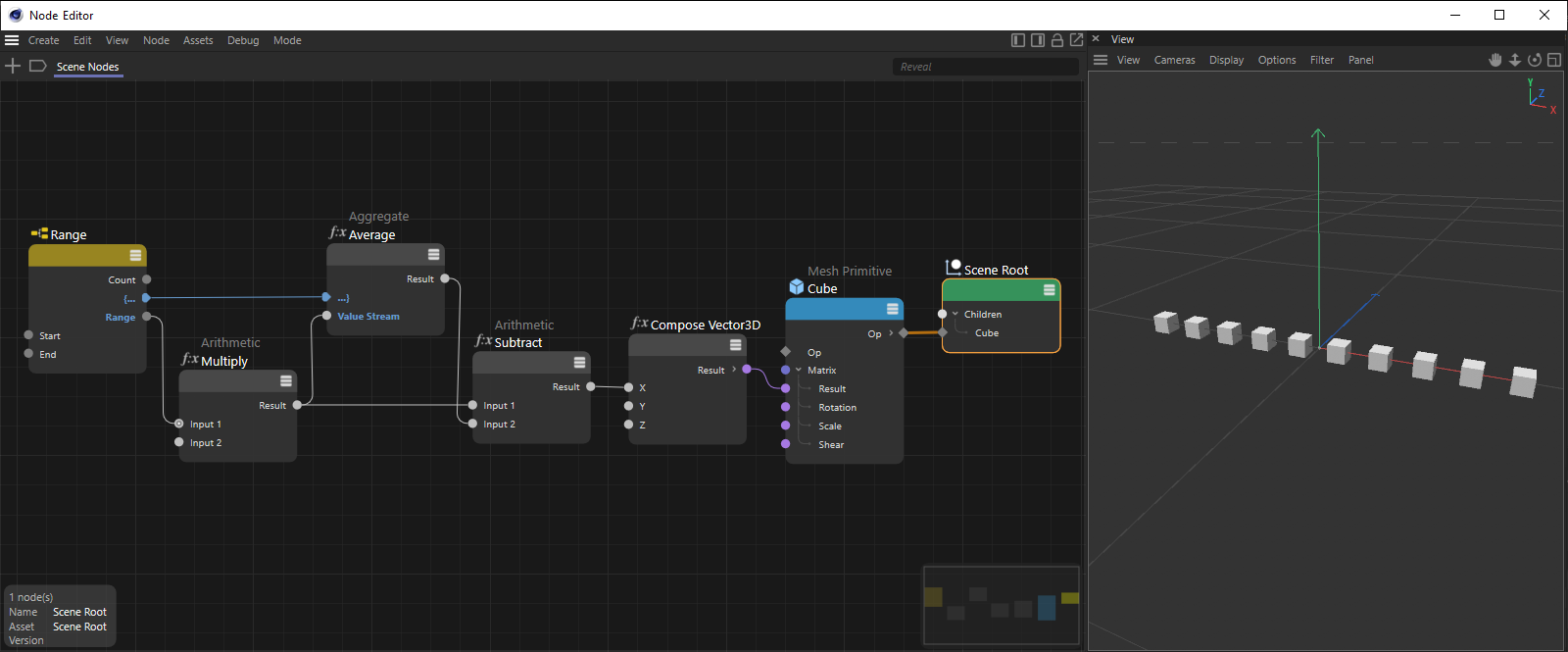 An example for a linear distribution of object copies that are centered on the Null point.
An example for a linear distribution of object copies that are centered on the Null point.
Node such as the Range Node, which can be used to define loops, have Ports with a curved bracket. Here, Nodes of this type can communicate with one another and synchronize. A sequence can be defined within the setup in which calculations take place.
In the example above, the Range Node, for example, outputs a numeric sequence from 0 to 10 that is multiplied by a defined value in order to calculate various points along the X axis that are then assigned to the respective objects.
In order for the positions to always be calculated centered with reference to the range output, an Aggregate Node calculates the average of all position values. This calculation must be completed so the Subtract Node can access the result of this calculation. In order for this to work, the Bracket Ports of the Range and Aggregate Nodes must be connected with one another. The symbols at these Ports create a frame with an open and closed bracket, which shows that this range - including the enclosed Math Node - is to be treated separately from the rest of the setup.
The Bracket Ports can also be applied in a staggered manner in order to create nested loops, as shown in the example below.
 Several Range Nodes can be output sequentially. Via the Bracket Ports, several of these Nodes can be connected in order to create nested loops. For each output number of the linked Range Node, the complete value range of the second Range Node is output.
Several Range Nodes can be output sequentially. Via the Bracket Ports, several of these Nodes can be connected in order to create nested loops. For each output number of the linked Range Node, the complete value range of the second Range Node is output.
In the example above, when the Range Node on the left outputs a new value, the Range Node on the right will run through all of its defined values and output them one after the other. This way, very simple, uniform grids for position values, for example, can be created or UV coordinates can be run through. The X and U values will then, for example, be calculated by the first Range Node and the Y and V values by the second Range Node. In these cases, all Bracket Ports will only display opened curved brackets. The subsequent Nodes are all equally dependent on both Range Nodes.
In general, the connections between Nodes used for synchronization will be colored blue and the Ports that output a swquence of values will also appear blue.
Context menu
If you right-click on a Node/port, a comprehensive context menu will open, which contains commands mostly from the Node Editor menu. These are described here, except for the following:
Here you can switch the respective Nodes (e.g., Geometry objects) from the Base Node to OP Node and vice-versa.
Not all inputs listed in the Attribute Manager have to be displayed by the Node as a port. Sometimes only the most important are shown. Use the Add Port command to show all hidden ports. If one is selected, it will be displayed again (if All is selected, all input ports will be made visible).
This menu point is not available if all input ports are displayed.
Normally, all outputs are displayed. If not, (e.g., if Remove Unused Ports was applied) these can be displayed by selecting one of the output ports from the list.
Propagate Port
A list will be displayed from which a Node to which you can link can be selected. If multiple output ports come into question per Node, click on the small black arrow and the output ports that can be selected will be displayed. In addition to the complete Asset list, the first entries will be existing Nodes where Nodes are listed that are contained in the current Node Editor view. There is also the Add Group Input option with which a port can be drawn from a group (see also Input and Output Group Areas).
Note that this list is created dynamically, and only fitting Nodes will be suggested.
Replace Node
For the current, connected input port, the "feeding" Node will be replaced by one from the list. Note that the complete Node chain will be deleted at the Node to be deleted. This only applies to the Nodes being fed: Nodes that are connected to other output ports remain unaffected.
Textures
All loaded textures are listed here. Select a texture from the list to feed it into the input port. This command is only available when using the Material mode in the Node Editor.
Load Texture
Selecting this option will open a context window from which you can select a bitmap or video, which will then be fed to the input port using an Image Node. This command is only available when using the Material mode in the Node Editor.
Remove Port Instance
Several Nodes such as the Redshift Ramp Node make this command available. With it you can delete elements such as Layers or Knots. Since we are again dealing with variadic ports, you can edit the number of ports directly at the Node using the mouse. If the cursor is positioned to the right of the variadic Group port (e.g., next to Ramp for a Redshift Ramp Node), a Plus symbol will appear that can be used to add ports to the Ramp's gradient. If the cursor is positioned next to these ports, an x symbol will appear that can be used to remove these ports.
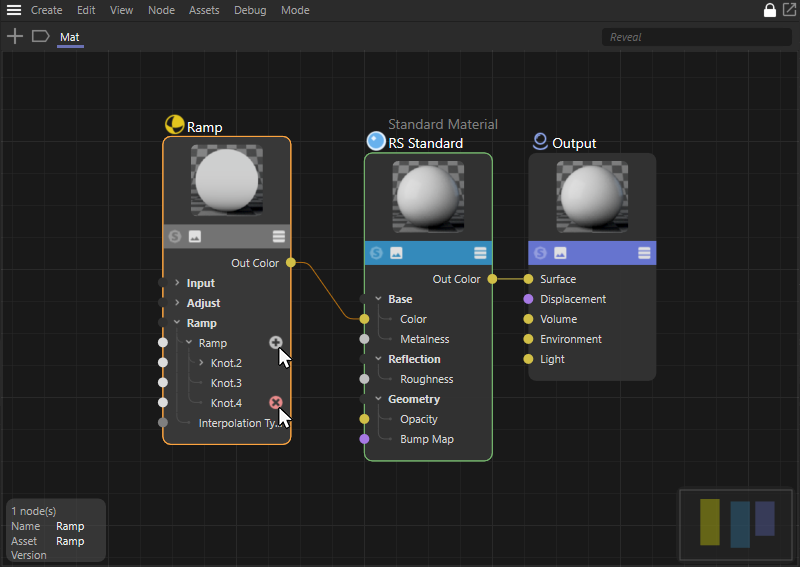 Variadic ports can be added or removed directly at the Node itself.
Variadic ports can be added or removed directly at the Node itself.
Selecting this command will hide the selected ports. This only works with ports that are not connected. The hidden port will then appear in the previously described list under Add Input (and can be made visible there).
Note also the Show All Ports command and the next two commands described there. This is a different functionality from the hiding or displaying of ports.
This command is only available if the context menu for a given Node is opened and the Display Comment option is enabled in the Node's Basic settings (or the Display Comment option for a Redshift Material Node). Here you can enter a text in the Comment field directly beneath the Node. This can be very helpful in maintaining a better overview when working with complex setups and, for example, for describint the function of individual setup elements. Calling up this command again will hide it.
Details about these two Debugging tools can be found there. These functions make it possible to directly read the values delivered by the ports, which in turn makes it easier, for example, to locate calculative errors in the setup.
Most settings have a default value, which is defined when the Node is created. Using this command, modified values will be reset to their default values. This only affects Nodes that are not connected.
Propagate Port
Calling up this command (only of use when the Node Editor view shows a group's contents) creates a connection to the outside or to the parent hierarchy. See also Input and Output Group Areas.
Here you can copy values/types of individual ports to the cache (for a port with an integer value of 4 it would, for example, look like this: int64:4). These values/types can be pasted to other selected ports using the Paste Value command. The data types will be converted, if possible.
A data type can be copied using this command (fora port with an inter value of 4 it would, for example, look like this: int64). Since it's possible to create very complex data types (e.g., an Array Collection with different data types, as they are output by distributed Scene Nodes.) you can use this command to save time by simply copying the data type and paste it at the desired location. For example, for a Compose Container Node, for which you can also define data types, click on the button at the far right of Data Type and select Edit Data Type and paste the data type there.
A Solo functionality can be enabled for Material Nodes. If this Node has multiple outputs, one of them must be defined as a Solo Port, which is what this option does.
In the upper area of a Node you will find the Node's preview. If a Node has multiple outputs, this option can be used to define which output should be displayed in the preview.
Connections
Proceed as follows to connect a Node port with another port:
Connections can also be selected, whereby you can almost always do so in conjunction with the Shift and Ctrl/Cmd keys to add or remove selections (clicking and dragging a box can also be used to make a selection). So what can be done with selected connections? They can, for example, be deleted or modified per context menu commands described below (only those commands not described elsewhere are described below).
Deletes selected connection.
Muted connections will be displayed with a dashed line. Values will not be accepted from the previously connected Node but from the Attribute Manager instead. This lets you temporarily disable connections for test purposes, for example.
Other Node Editor components
The icons at the top right
At the top right of the Node Editor you will find the following 3 icons, from left to right:
- Show assets at the left edge of the Node Editor: An instance of the Asset Browser will be displayed at the left edge of the Node Editor where you can select or add Nodes or textures to a setup. Otherwise you can also open the Asset Browser via a double-click in an empty area of the Node Editor at any time.
- Show attributes at the right edge of the Node Editor: This is particularly helpful when working with an undocked Node Editor that might otherwise cover the Attribute Manager in the layout. It also helps to speed up workflow if you have to travel less with the mouse to reach a particular function in the Attribute Manager and settings for a given Node can be shown and edited directly in the Node Editor.
- Lock Node view: Normally, the Node view will, for example, always show the Mode Material currently selected in the Material Manager. If the view should not switch when a material is selected, you can lock it with this function. This can also help to distribute different groups or sections of complex setups across multiple Node Editors to maintain a better overview.
- New Node Manager: This will open a new Node Editor. This can, for example, be helpful if you have a Node network made up of hundreds of Nodes and want to work in several areas simultaneously. Or you want to make the Nodes of two Node Materials visible at the same time (see also previous icon). A newly-created Node Editor has this lock activated by default.
Connectors
The most major change compared to the previous Attribute Manager are the linked fields that have been replaced by Connectors. Node inputs can either be fed with values by simply entering values for given settings or - and this is new - by connecting Node inputs with node outputs of other Nodes, i.e., make a connection (which is what Nodes are all about).
Click on the icon at the right of the setting name (the "connector") and select a Node from the Connect Node list to connect with the input that you select (you can, of course, simply connect ports in the Node Editor view). The selected Node will be created and linked:
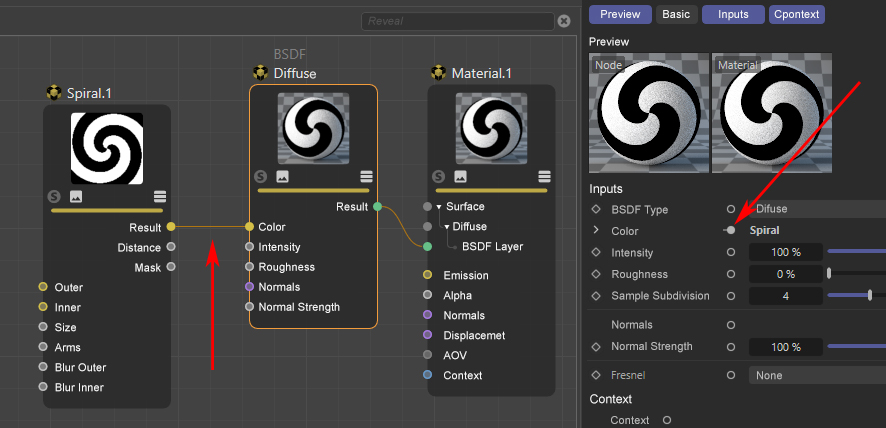
Bitmaps can at any time be dragged from outside of Cinema 4D onto a complete parameter line *incl. parameter name, connecting icon and GUI element) to link a given setting using an Image Node.
As soon as a parameter is connected with another Node, the following applies:
- A small arrow will appear instead of the animation icon. Click on this arrow to display the settings of the docked Node.
- The setting can no longer animate these using the usual animation icon - this will then be displayed (of course you can animate the setting of the connected Node as usual). A setting cannot be controlled simultaneously by the Timeline and another Node.
The connector icon can have one of the following 3 states:

- Connected: The values flow from the linked Node to the Node input. On the right next to the Connector, the linked Node's name will be displayed. You can click on this name to select the corresponding Node and display its settings.
- Muted: A connection to another Node exists, whose values will, however, not be assumed (instead, the values defined in the Attribute Manager will be used).
- Disconnected: The values defined in the Attribute Manager will be used.
Clicking on a connector icon will make the following commands available, from which most should already be familiar from the port context menu. The connector icon makes a similar functionality available, which makes it possible to access a port in the Node Editor per right-click.
In the following, only the Connector's commands are described.
Add Layer
This command can, for example, be found in the Layer Node. The selected Node will be linked with a new layer.
Copy
Copies the connected output port to the cache.
Paste (Duplicate)
This command connects the output port in the cache with the input on which you click. Contrary to the previously described command, a duplicate of the entire feeding Node is created.
Remove
Removes the connection from the input port.
Mute Port
The connection is maintained but no data will be passed. Instead, the value defined in the Attribute Manager will be used for the input. Call up the command again to allow data to be passed again.
Show in Node Editor
Shows the respective Nodes/Ports in the Node Editor. Alternatively you can Ctrl + click on the link icon.
This lets you quickly connect multiple parameters selected in the Attribute Manager with Nodes in the Node Editor.
Show Subchannels
Several Nodes such as the Layer Node or Grading Node offer this mode. Enable this mode, for example, to display the layer settings as animatable or adjustable settings. In addition, the input settings of the feeding Node can be displayed by activating one of the layers. In the following example, the inputs would be those of the Circle Node.
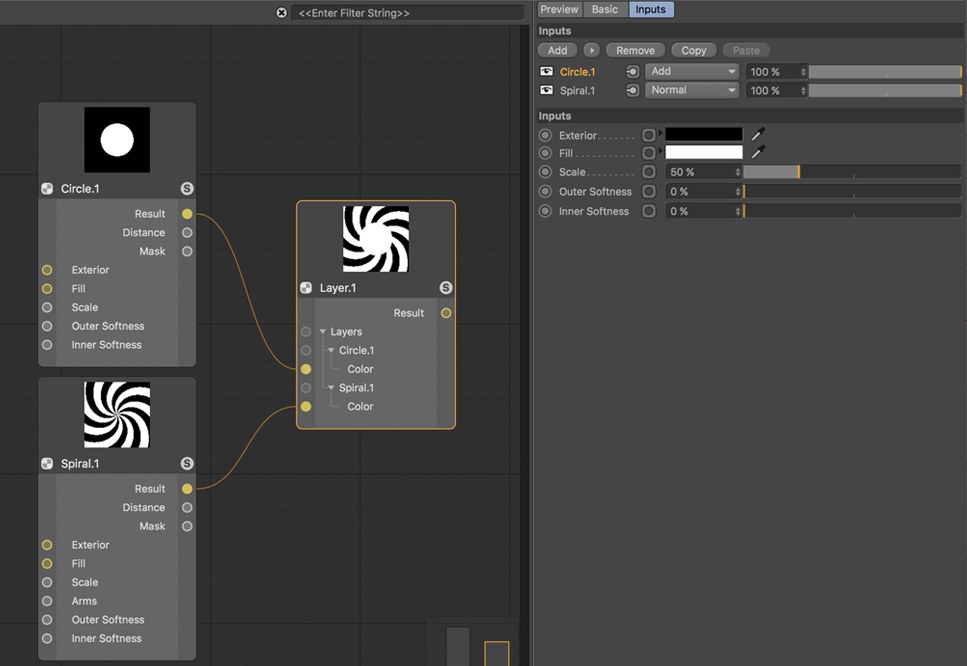
Inherit Interface
Several Nodes such as the Distance or Value Nodes, for example, can assume the units and parameter settings of the subsequent connected Node for an Input port.
Info area
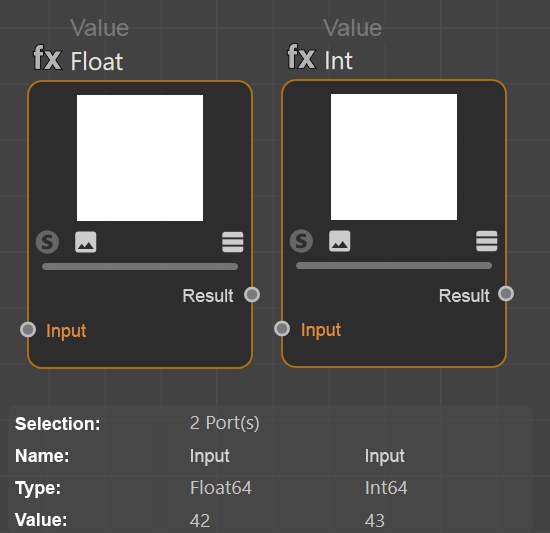 Multiple port selections are also possible in order to compare values.
Multiple port selections are also possible in order to compare values.
At the bottom left you will find the scalable Info area in which you will find information pertaining to Nodes, connections and ports.
For Nodes:
- Selection: The number and type of selected elements
- Name: The Node name as it is defined in the Basic tab
- Asset: The non-modifiable Asset name as it is defined internally. Why do the Asset and Name infos differ? You can change the Name at any time which will differ from that in the Help. Since Cinema 4D R23, however, both names will be displayed on the Node.
- Version: When you create Assets, a version number can be defined, which is then displayed here, including date and time. This way you always know which Asset version you are currently using.
- Asset ID/ID: these are unique IDs. They are of no real informational value but can be of interest for asset developers.
- Errors: Here all errors will be displayed (e.g., if an automatic conversion of a data type failed)
Additional information for connections:
- Selection: The number of selected connections
- Port Type: The data type that the port expects as input or itself puts out
- Connected Type: The data type that flows through the connection
Additional information for ports:
- Port Value: If a port has no connection, the value defined in the Attribute Manager will be displayed
Material Node example scene
The following material was created using Nodes only. Not bitmap or texture was used!
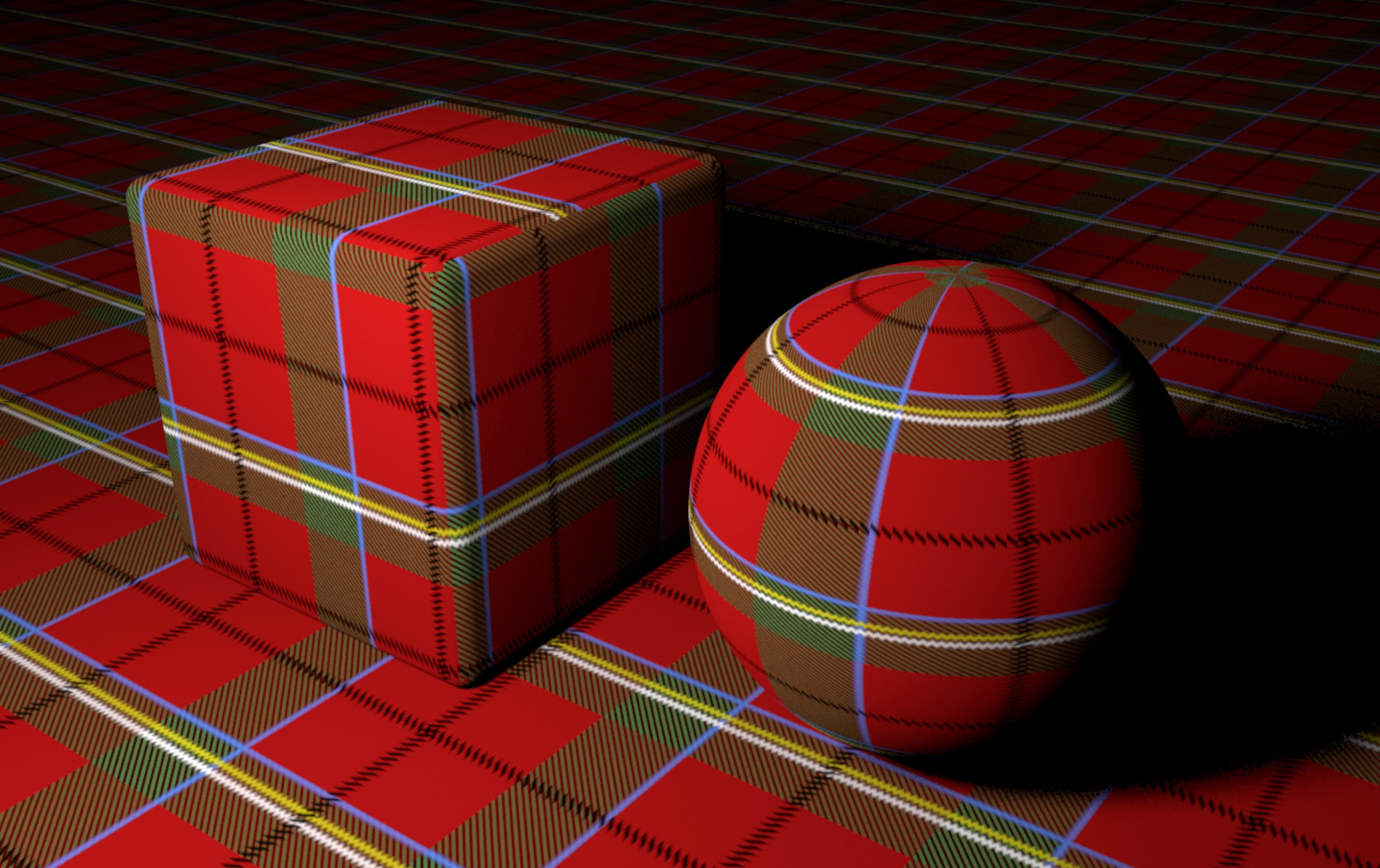
Load the following scene:
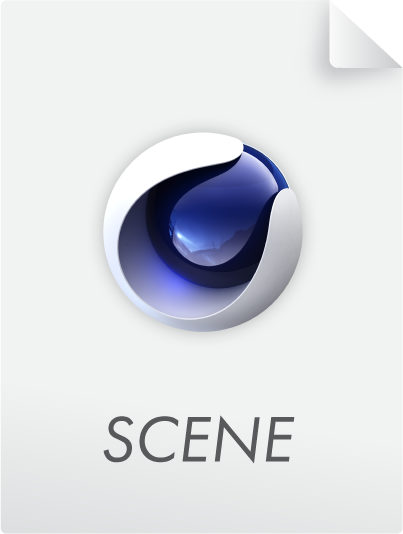
Here you can get an idea of what is possible using Nodes. Right-click on the material and select Node Editor to see what the Node setup looks like. Note the Plaid Group Node in which additional Node networks are nested.
Special information about the Scene Node Editor
Aside from the descriptions above, the Scene Node Editor has several special features:
- Several Nodes in the Scene Node Editor have a thicker Op connection, as shown in the image below between the Capsule and the Scene Node:
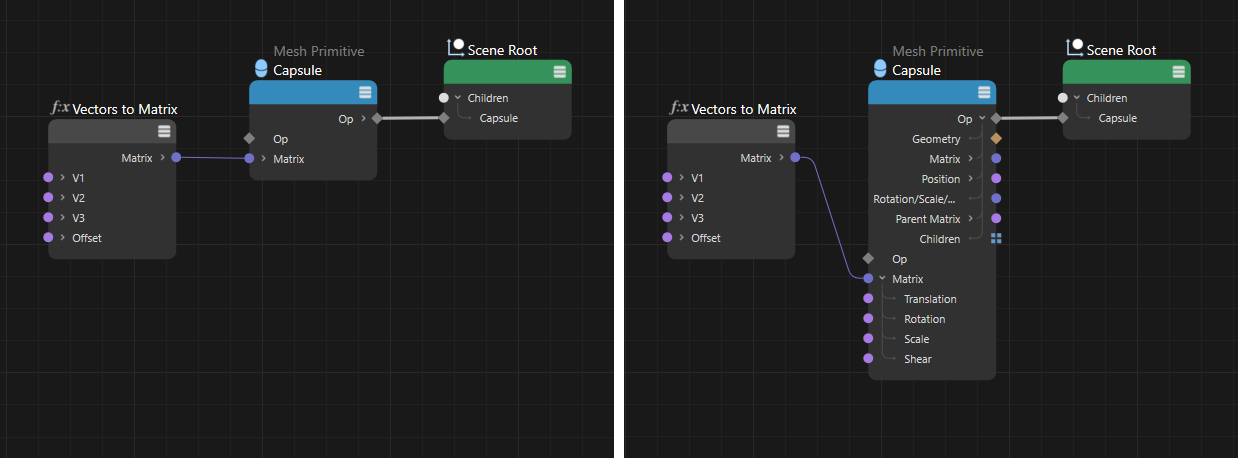
These connections are a conglomerate of different values.
Click on the small arrow at the Op output port to open them and display the value type. To create geometry that is visible in the scene, a Op output must always be connected with the Scene port. Other ports such as the Matrix Input port in the image above can be opened in order to set or evaluate individual parts of this file format.
- Nodes in the Scene Node Editor often have not preview
- Nodes in the Scene Node Editor have no Solo Mode
If, for example, you search for "Oil Tank", you will only be shown 1 result, contrary to versions prior to S26. This is because all Node versions are no longer shown (Base Node, OP Node). Instead you can drag an oil tank into the Node Editor, Scene Manager or Object Manager. The oil tank will then be evaluated as a Base Node or Asset Capsule.. The Switch Node Type command can then be used to switch between Base and OP Node in the Node Editor.